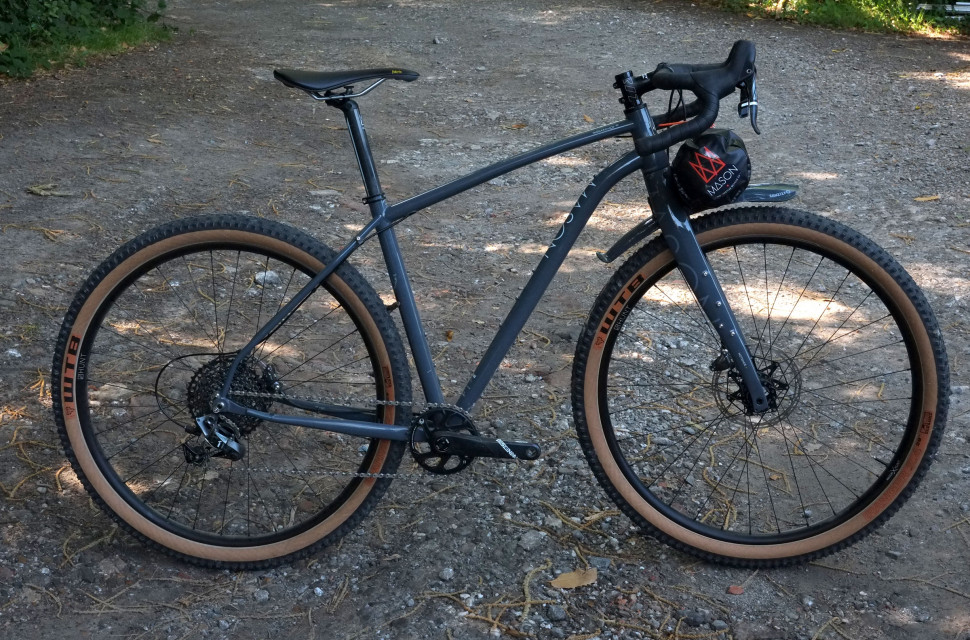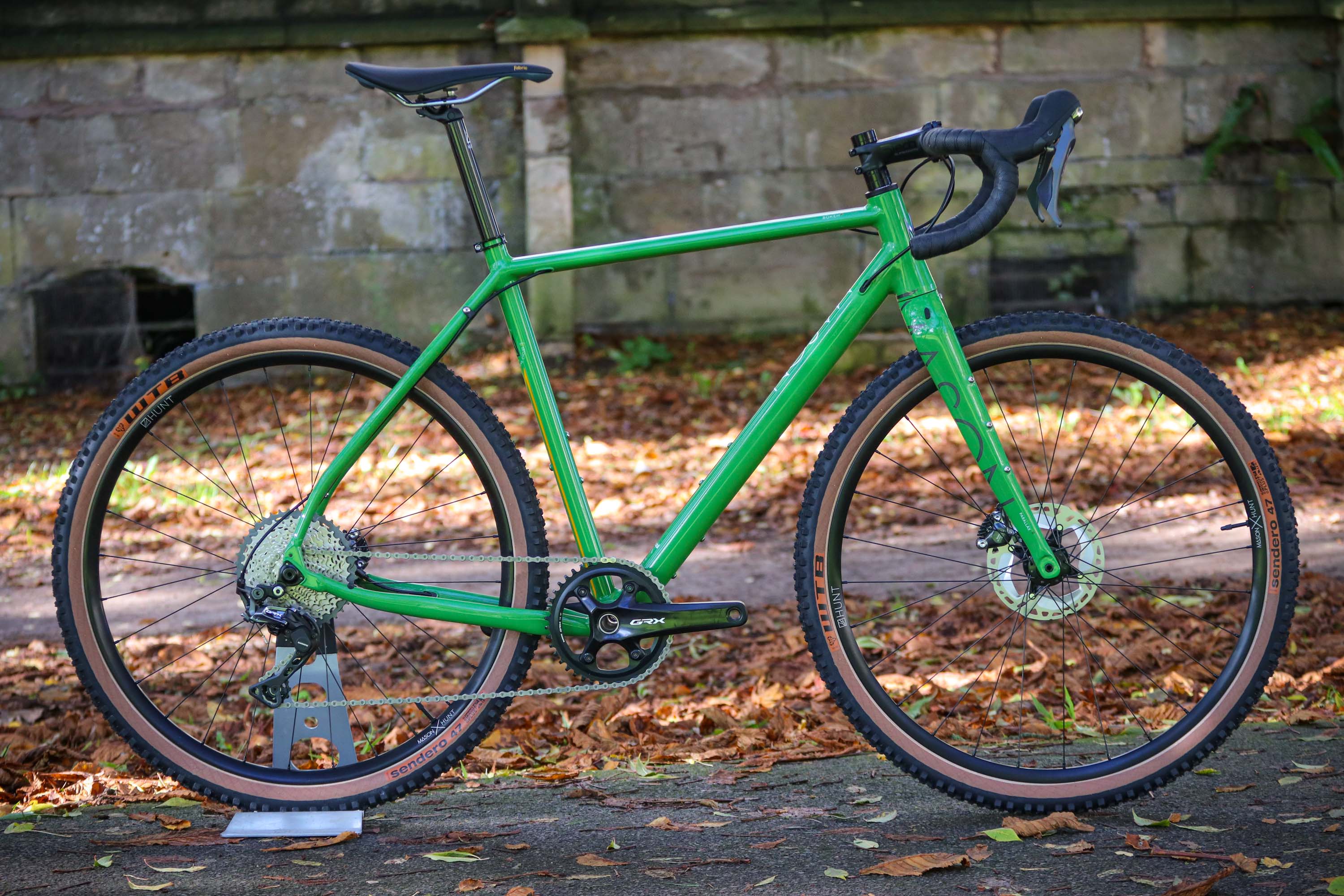You are using an out of date browser. It may not display this or other websites correctly.
You should upgrade or use an alternative browser.
You should upgrade or use an alternative browser.
Difference between modern Rigid MTB and Gravel
- Thread starter ibbz
- Start date
- Feedback
- View
Both rigid MTB's and gravel bikes have shifted a fair bit in the last few years so they can look quite similar I guess but they come from different directions.
Gravel is defo heading more towards an off road geometry rather than the road bike with more clearance and bigger tyres that it started as. Seat tubes are getting shorter, as are stems where as top tubes and bars are getting longer. Forks tend to be shorter and head tubes longer than adventure bikes still though and there's still plenty of GB's about that are more road focussed.
The flat bar bikes seem to be coming from a more old school MTB direction IMO, a natural progression after modern MTB geometry went in a very different direction. This style geometry seemed to flirt with the hybrid market for a while and kept narrower bars + tyres but more and more seem to be beefing up and going down the adventure route. This being the case and seeing how gravel has changed they have started to tread on each other's toes I guess? They are different though.
I spent a lot of time thinking about what style bike fits where in the last year or so as I was trying to get a collection that covered all my bases. I thought of it as a chart with race road bikes at one end, downhill MTB at the other and everything else in-between. Each style would be best for a certain terrain but others would also be capable, even if they were not the best tool for the job. The trick was to work out where I wanted to ride and therefore the best collection to cover the most bases. The chart was something like:
Race road- Road----- Hybrid- Gravel- Adventure MTB------ Short travel MTB- ---Downcountry------ All mountain- Enduro- Downhill.
Tarmac--------------------- Gravel track-- Canal/fields-------- Traditional trails---------Trail centre/technical natural-------Bonkers.
..... or something like that. So a GB could ride traditional trails but a short travel MTB would be better, an all mountain bike could ride steady fields but it would be overkill and the adventure MTB better suited, etc, etc. You could ride a road bike on a downhill course or DH bike up a tarmac hill but both would be hideous.
I have a 29er full suss that covers as far as I want to go towards bonkers and also a GB that I enjoy exploring canals, bridleways and back roads. When I got the GB I sold my road bike as I didn't like busy roads or being limited to tarmac. I then got a rigid On One Whippet as I'd always wanted to try a modern XC bike but found it covered the same bases as the GB so sold it and am now building a 650b hard tail to sit around the traditional trail/trail centre space.
IMO there's room for all the various styles of bike as riding them is ace! You just need to work out where you actually ride, where you want to and what bike(s) will allow you to get the most enjoyment from it.
Gravel is defo heading more towards an off road geometry rather than the road bike with more clearance and bigger tyres that it started as. Seat tubes are getting shorter, as are stems where as top tubes and bars are getting longer. Forks tend to be shorter and head tubes longer than adventure bikes still though and there's still plenty of GB's about that are more road focussed.
The flat bar bikes seem to be coming from a more old school MTB direction IMO, a natural progression after modern MTB geometry went in a very different direction. This style geometry seemed to flirt with the hybrid market for a while and kept narrower bars + tyres but more and more seem to be beefing up and going down the adventure route. This being the case and seeing how gravel has changed they have started to tread on each other's toes I guess? They are different though.
I spent a lot of time thinking about what style bike fits where in the last year or so as I was trying to get a collection that covered all my bases. I thought of it as a chart with race road bikes at one end, downhill MTB at the other and everything else in-between. Each style would be best for a certain terrain but others would also be capable, even if they were not the best tool for the job. The trick was to work out where I wanted to ride and therefore the best collection to cover the most bases. The chart was something like:
Race road- Road----- Hybrid- Gravel- Adventure MTB------ Short travel MTB- ---Downcountry------ All mountain- Enduro- Downhill.
Tarmac--------------------- Gravel track-- Canal/fields-------- Traditional trails---------Trail centre/technical natural-------Bonkers.
..... or something like that. So a GB could ride traditional trails but a short travel MTB would be better, an all mountain bike could ride steady fields but it would be overkill and the adventure MTB better suited, etc, etc. You could ride a road bike on a downhill course or DH bike up a tarmac hill but both would be hideous.
I have a 29er full suss that covers as far as I want to go towards bonkers and also a GB that I enjoy exploring canals, bridleways and back roads. When I got the GB I sold my road bike as I didn't like busy roads or being limited to tarmac. I then got a rigid On One Whippet as I'd always wanted to try a modern XC bike but found it covered the same bases as the GB so sold it and am now building a 650b hard tail to sit around the traditional trail/trail centre space.
IMO there's room for all the various styles of bike as riding them is ace! You just need to work out where you actually ride, where you want to and what bike(s) will allow you to get the most enjoyment from it.
Both rigid MTB's and gravel bikes have shifted a fair bit
I think Mason are perfect example of this.
They have the Definition and Resolution which are "4 season" road bikes - not out and out racers but bikes designed for long road rides but with bigger tyres and discs
Then the Bokeh and ISO which are interpretations of a gravel bike but coming at it from different directions.
As you say, its about determining where your riding preferences sit on the spectrum.
If I had the cash I'd have gone for an ISO - they weigh a good bit less than the cascade - but the cascade was £649 (on sale) and the ISO is £1600 and I don't like it enough to spend an extra grand on a bike that is very, very similar.
Mason ISO

Mason Bokeh

- Feedback
- View
Cor, the ISO wheelbase looks short! Not sure about that TBH....
Also see Nordest for variations on the gravel theme. It's probably not helpful lumping all the drop barred bikes in the gravel group thinking about it as they vary so massively, same as mountain bikes.
Also see Nordest for variations on the gravel theme. It's probably not helpful lumping all the drop barred bikes in the gravel group thinking about it as they vary so massively, same as mountain bikes.
I think they keep the drop bars just so they can label it as a Gravel.
They don’t make sense to me as in my opinion the vertical brakes with awkward shifters aren’t as ergonomic nor as practical as brakes on a flat bar with either trigger or twist shifters.
If they were to add these things then the Gravel category would cease to exist and the bike would be a MTB.
I think a lot of this is down to maintaining some heritage or connection with the past - weren’t drop bars originally designed for racing? So in order to be a “Road” bike and to be taken seriously you have had to have had drop bars (otherwise it’s a lowly Roadster or something unworthy)
I did notice that when Gravel first appeared, I and many others confused them for CX bikes.
They don’t make sense to me as in my opinion the vertical brakes with awkward shifters aren’t as ergonomic nor as practical as brakes on a flat bar with either trigger or twist shifters.
If they were to add these things then the Gravel category would cease to exist and the bike would be a MTB.
I think a lot of this is down to maintaining some heritage or connection with the past - weren’t drop bars originally designed for racing? So in order to be a “Road” bike and to be taken seriously you have had to have had drop bars (otherwise it’s a lowly Roadster or something unworthy)
I did notice that when Gravel first appeared, I and many others confused them for CX bikes.
I think they keep the drop bars just so they can label it as a Gravel.
They don’t make sense to me as in my opinion the vertical brakes with awkward shifters aren’t as ergonomic nor as practical as brakes on a flat bar with either trigger or twist shifters.
If they were to add these things then the Gravel category would cease to exist and the bike would be a MTB.
I think a lot of this is down to maintaining some heritage or connection with the past - weren’t drop bars originally designed for racing? So in order to be a “Road” bike and to be taken seriously you have had to have had drop bars (otherwise it’s a lowly Roadster or something unworthy)
I did notice that when Gravel first appeared, I and many others confused them for CX bikes.
Somebody who could delve into archives would have an interesting research topic right there.
Back 100 years ago or more, different handle bars were options on new bikes. You can clearly see here the point was to offer possibilities for personal preference, rather than type casting bikes how it is today.
CassidyAce
Senior Retro Guru
This: ^.IMO there's room for all the various styles of bike as riding them is ace! You just need to work out where you actually ride, where you want to and what bike(s) will allow you to get the most enjoyment from it.
The 'gravel' label is just a label, useful for marketing and pigeonholing, but the reality is that there is now much more choice for riding on that middle ground where a mountain bike, especially full suss, is overkill and inefficient, and a road bike is too delicate, harsh and lacking in grip. Before gravel bikes, there were hybrids, CX bikes or a very slim selection of rigid mountain bikes (many of which were BSOs). Unless you went down the retro MTB route, which is what I did. Now, there are drop bar gravel bikes, flat bar gravel bikes, and some that offer the choice between flat bar and drop bar, e.g. Sonder Camino. Some are closer to road bikes and some are closer to mountain bikes... And that's all good. We can choose something well suited to the local terrain and preferred riding. What's not to like? It's not as if road, hybrid and mountain bikes have gone out of production in the meantime. I don't see much point in getting too focused on the 'gravel' label; why not just enjoy the choice?
Similar threads
- Replies
- 58
- Views
- 9K

